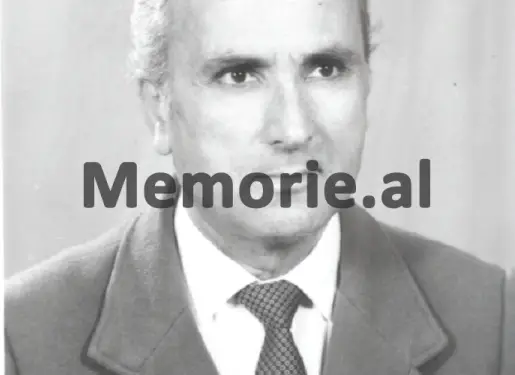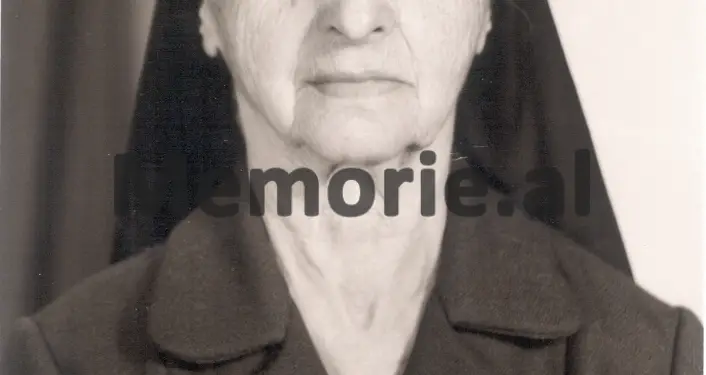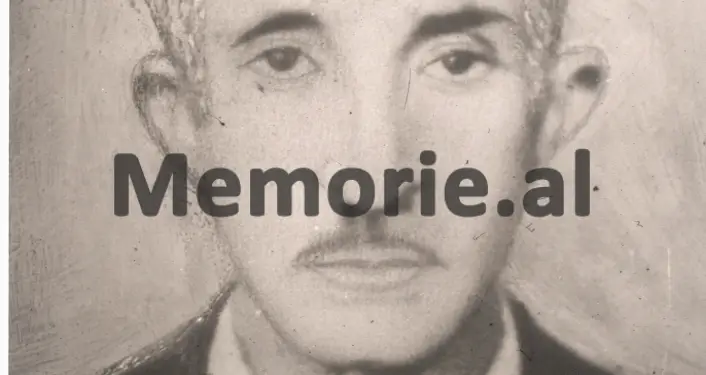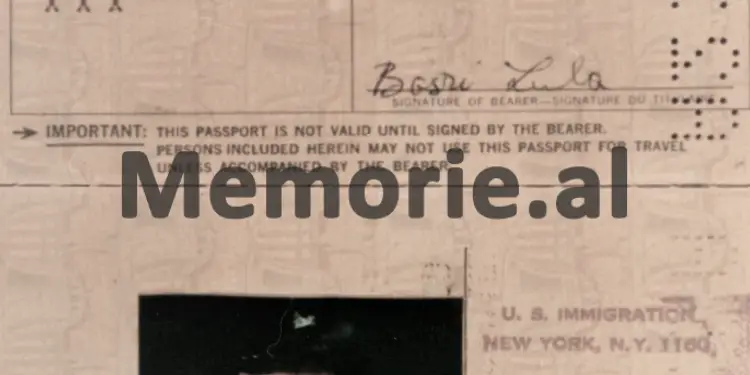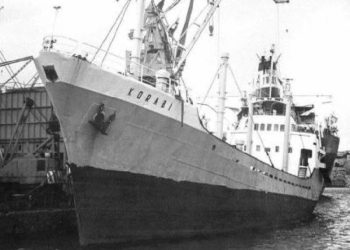Dashnor Kaloçi
The first part
Memorie.al publishes the unknown and sensational story of the so-called “Xhevdet Mustafa gang”, which included: Sabaudin Haznedari, Xhevdet Mustafa and Halit Bajrami, who at midnight on September 26, 1982, by means of a small motorboat that had set off from the Italian coast, landed on the coast of Divjaka, where after killing a police officer and a villager of the area, under the force of arms, held hostage another police officer, who would show them the way to advance inland Albanian, until they arrived in the small town of Rrogozhina, where they were discovered by the State Security people and after a gun attempt, its ‘capo’ Sabaudin Haznedari, was killed in a fire center, and also the same “Lucky” would also be Xhevdet Mustafa, who was killed after a few hours, in a house in the village of Zhamë in Lushnja, after he had previously killed the owner of the house and a police non-commissioned officer who was following him on a motorcycle. The rare testimony of Gafurr Haznedari from the city of Durrës, the brother of the ‘kapos’ of that gang, who tells for the first time the whole story of the so-called “Xhevdet Mustafa gang”, which according to the version of Enver Hoxha, was sent by UDB in collaboration with Leka Zogu, in order to assassinate the first secretary of the Central Committee of the ALP. ” and the well-known playwright, Sulejman Pitarka, would dedicate the drama “The Fisherman Family”, as well as all the State Security combinations, from their escape until the event of September 26, 1982, when Sabaudini and Xhevdet remained killed, in an effort with the forces of the Ministry of Internal Affairs, while Halit Bajrami, after being held for some time in the “Investigator” and the Hotel “Tirana”, was escorted by the Albanian Intelligence to New Zealand, where he lived peacefully even after years ’90s, refusing to trespass more in Albania!
Full 39 years ago, on the morning of Sunday, September 26, 1982, an unusual and very sensational event took place in a small town in Central Albania. He broke the silence and the stifling monotony that prevailed for years in the communist Albania of that time, causing great confusion and panic even in the ranks of the high hierarchy of the communist leadership led by Enver Hoxha. That same afternoon, the news of that event, which had spread with an unusual speed almost all over the country, was narrated in various forms. It was also announced by the Albanian Radio-Television, through an official announcement given through an official communiqué of the Ministry of Internal Affairs, which was broadcast on the news program at 20.00. That official communiqué, among other things, announced that: ‘an armed gang financed and trained by the secret services of some neighboring countries, in cooperation with the enemies of the Albanian people, had landed several kilometers. in the depths of the Albanian territory on the coast of Divjaka, where it was completely destroyed by the forces of the Ministry of Interior ‘.
Nearly two months later, still without echoing the echo of that event, during a meeting that the leader of communist Albania, Enver Hoxha, held with the voters of his constituency in Tirana, among other things, he spoke about the “gang” that had already become known, all over Albania, as the “Xhevdet Mustafa Gang”. In this regard, he said: “The armed gang of the criminal Xhevdet Mustafa, which was prepared and financed by Leka Zogu in cooperation with the Yugoslav UDB and the foreign secret services of some neighboring countries, was annihilated and completely eliminated inside six hours from their landing, still without seeing the Albanian sun well “.
This sensational event, which at that time shook the whole of Albania and opened a great panic for several months in a row, putting on high alert all the units of the Armed Forces and volunteer detachments, was spoken and written only after the ’90s, with the collapse of the communist regime, but again, the whole event of September 26, 1982, in which Sabaudin Haznedari and Xhevdet Mustafa were killed, as well as the so-called “Xhevdet Mustafa gang”, although four decades have passed since then, continues to remain shrouded in mystery, bearing upon itself a series of question marks!
In this context, with the aim of trying to shed some light on that distant event, Memorie.al returns to a cycle of articles about the so-called “Xhevdet Mustafa gang”, publishing new facts and events previously unknown, which come through the interview with Gafurr Haznedari from the city of Durrës, who is the brother of Sabaudin Haznedari, the leader of the “commando group”, who, together with Xhevdet Mustafa and Halit Bajrami, landed on the coast of Divjaka in the distant midnight of 26- September 1982, where according to the official Tirana version articulated by Enver Hoxha himself in his speech before his constituency voters in Tirana, “he was sent by the UDB in collaboration with Leka Zogu, in order to kill the secretary the first of the Central Committee of the ALP ”.
After the interview with Mr. Gafurr Haznedari that will be published in six consecutive issues (starting today), Memorie.al will continue again with other articles, testimonies and interviews, from actors of that event, relatives of their families, as well as witnesses which, by chance, connected them, or led them to the place where 39 years ago the ‘armed commando group’, otherwise known as the “Xhevdet Mustafa gang” landed, an event which even today, after four decades, continues to remain covered with mystery.
Rare testimony of Gafurr Haznedari, brother of the “gang leader” Xhevdet Mustafa”
“My brother Sabaudin Haznedari, was the leader of the ‘gang’, who, together with Xhevdet Mustafa and Halit Bajrami, landed on the coast of Divjaka, at midnight on September 26, 1982. Together with the three of them, he had prepared at the training bases. Another person, (FK) who shortly before the gang boarded the motorboat that was going to sail, towards the Albanian coast, became ill and allegedly set off to buy medicine. “After the suspicious departure of that person who has come to Tirana several times since the 1990s, my brother Sabaudini changed his voyage and landed in another place, to avoid security traps.” among others, regarding the so-called “Banda Xhevdet Mustafa”, Gafurr Haznedari, from the city of Durrës, who told us the whole story of that gang, where his brother, Sabaudin Haznedari, was its ‘capo’.
Who was Sabaudin Haznedari, what is his past and in what position was he appointed, after the end of the War? What was his clash with the senior leaders of the Albanian Communist Party in his hometown in 1945 and why was he expelled from the party, etc.?
Who was Halit Bajrami, since he met Sabaudini and how did they escape from Albania? Was Halit Bajrami’s escape for political purposes, because he was dissatisfied with the communist regime, or was it a State Security ploy devised by his boss, the Minister of Internal Affairs, Mehmet Shehu? How did the Haznedari family learn the news of Sabauddin’s escape and what they said to his father, Mahmud, when he was called to the Ministry of Internal Affairs? Where did they both settle after leaving Albania and why did Halit Bajrami insist on taking Sabauddin with him to New Zealand?
Where did Sabaudini and Haliti live from 1950 until 1982 when they came to Albania and did they keep the old ties and friendship? What happened to their families after the escape and why they were not harassed by Enver Hoxha’s communist regime, as was usually the case with the families and relatives of those fleeing Albania, and even more so when they had “hostile activity” against communist Albania ? How could Sabaudini connect with his family and who was the woman, who in 1962 he left Italy and met his wife, son and all the people of his house, in the city of Durrës?
How were the three members of the “gang” discovered in Rrogozhina and what is the truth of the murder of Sabaudin Haznedari in the bunker (fire center), where he was inserted? What happened to the Haznedari, Mustafa and Bajrami families on September 27, 1982?
What was written in the letter sent to Halit Bajrami in 1993, in New Zealand, and why did he never agree to return to Albania? Regarding these mysteries and other facts from the history of what is known as “Banda Xhevdet Mustafa”, Gafurr Haznedari from the city of Durrës introduces us for the first time with his exclusive testimonies.
Mr. Gafurr, after the end of the War, what did your brother Sabaudini do?
My older brother, Sabaudini, who had been in the partisan ranks and from the War became an officer with the rank of lieutenant, immediately in December 1944, was appointed Chairman of the National Liberation Council for the lower neighborhood “Varosh”, which at that time it covered half of the city of Durrës.
How long did Sabaudini take that job in Durrës?
Sabaudini did not serve in that position for long, because in 1945, he was removed from there and expelled from the party.
For what reasons did that happen, that is, his expulsion from the party?
That year, in the city of Durrës, elections were held for the leading forums of the local government and a large part of the main communists, who were very well known since the time of the War, such as: Skënder Çela, Drita Malile, Hysen Ballhysa, Mark Toçi etc., opposed the candidacies sent by the Central Committee of the Communist Party, from Tirana.
Haznedars in the city of Durrës, neighbors of the famous actor and playwright, Sulejman Pitarka, who dedicated to them the drama, “The fisherman’s family”
The early origin of the well-known Durrës family, Haznedari, from where Sabaud and Gafurr Haznedari come from, is from Dibra e Madhe, more precisely from the village of Prilep in Manastir. Sabauddin’s grandfather was named Vesaf Haznedari and was known throughout the Prefecture of Velika Dibra as the great-grandson of Sultan Hamiti. Vesaf’s son, Mahmud, who is also the father of Sabauddin and Gafurri, was born on September 15, 1887, in Prilep, Manastir, where he was educated first in a ‘Mejtep’ and then in a ‘Madrasa’.
Around 1927, Mahmud Haznedari with his family moved from the city of Bitola and came and settled in Tirana, due to the death sentence, which was given in absentia by a Slavic court, considered irredentist. After staying for two years in Tirana, Mahmud Haznedari and his family moved to the city of Durrës, where he lived for some time as a tenant, in an apartment near the Tower Tower. Then he bought a piece of land on the coast, in the place that even today Durrës people know as “Lands of battle”. On that land, which Zija bought from Kodra, Mahmud set up a hut on the coast?
Later, that barangay erected on the coast, which Mahmud filled with and around, was known and called by the people of Durrës as the “Fisherman’s Hut”. In those lands of the “battle” next to the Haznedari family, at that time lived the family of Sulejman Pitarka, (the great writer and actor), who a few years later, took the trigger and wrote the famous drama “The Fisherman’s Family” (which is entirely dedicated to the Haznedars) which was later screened by Kinostudio “Shqipëria e Re”, with the film “Oshetimë në bregdet”.
The elder of that family, Mahmud, with his wife. Lutfijen, (Strazimir) at that time had six children and the eldest of them was Sabauddin, who was born in 1922. After him came: Emini, Naimi, Abdurrahimi, Gafurri and Qerimi, who had an age difference of three to four years with each other.
Likewise, during the war, the “fisherman’s hut” became one of the bases of the Anti-Fascist Movement, where many of the main exponents of the Durrës Communist Circle took refuge and gathered, because, in addition to the old man of the house, Mahmud, and his three eldest sons, Sabaudini, Emini and Naimi, had joined the Anti-Fascist Movement, joining the Communist Party. In 1943, the Haznedari family moved from Durrës and came to Tirana, settling in a rented apartment on “Kavaja Street”, at the fountain of Lym Sharra. Even this house where the Haznedars settled in Tirana turned into one of the bases of the War, after her three sons, Sabaudini, Emini and Naimi, 14, had become partisans.
Emini, who at that time was a partisan in Peza’s gang, came home dressed as a peasant and with his donkey that allegedly brought wood for the kiln; he got ammunition that his father, Mahmudi, bought for the partisans. On November 16, 1944, a day before the Germans left Tirana, they burned down the Haznedari house, after during a search of its basements, and they found communist tracts and communiqués. Left in the middle of the road, eight days later (November 24, 1944), the Haznedari family moved back to the city of Durrës and settled in their former hut on the coast, which was already completely ruined./Memorie. al




